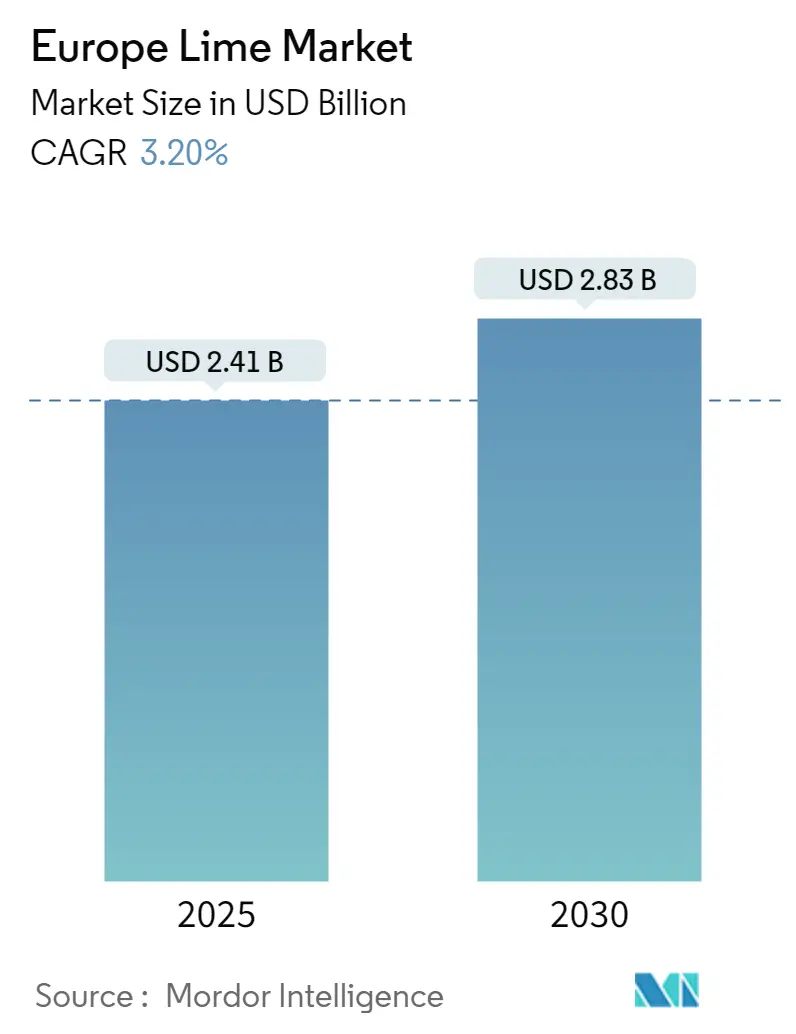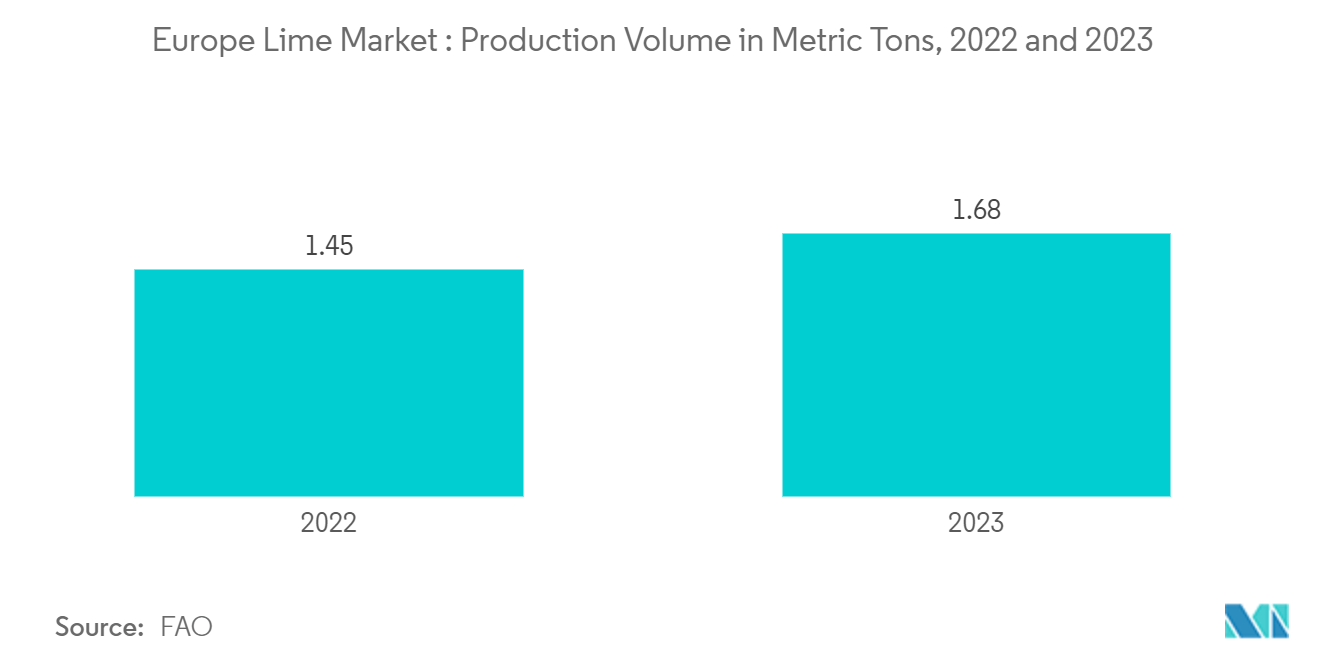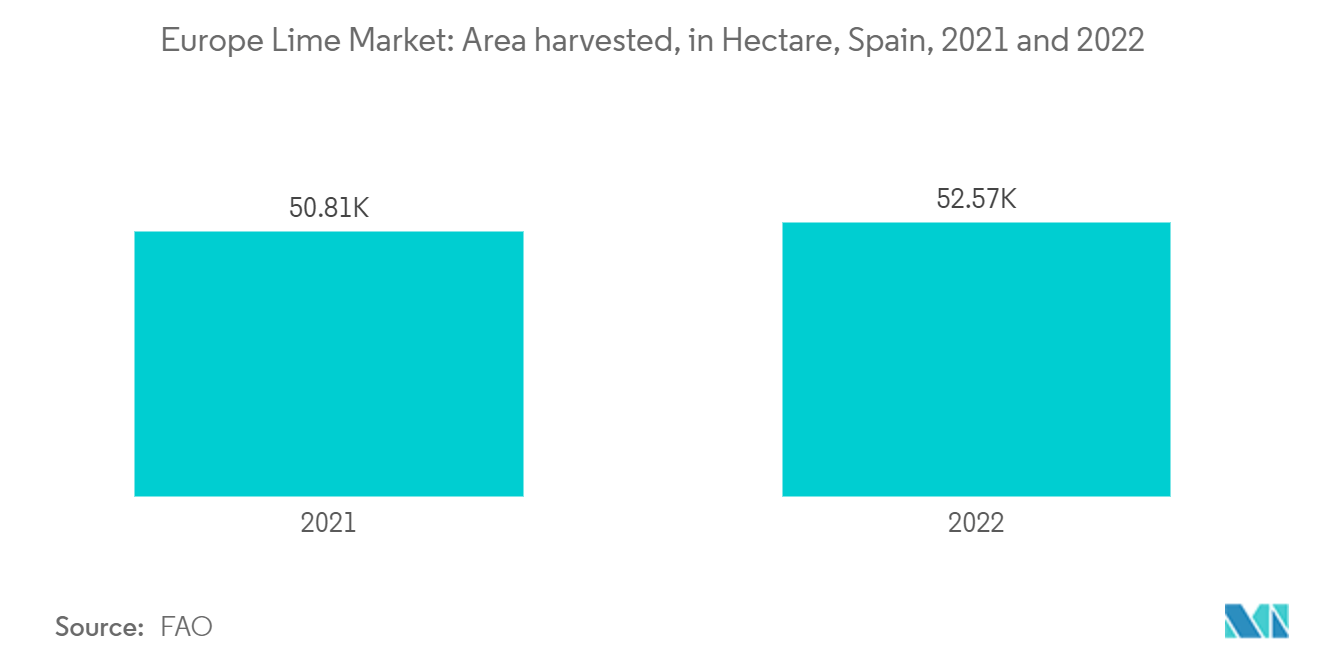
Europe Lime Market Analysis by Mordor Intelligence
The Europe Lime Market size is estimated at USD 2.41 billion in 2025, and is expected to reach USD 2.83 billion by 2030, at a CAGR of 3.2% during the forecast period (2025-2030).
- The European lime market has experienced significant growth in recent years, driven by increasing consumer demand and diverse applications in food, beverages, and cosmetics. Spain leads lime production in Europe, accounting for about 65% of the region's output, according to the Farm Advisory System European Union (FAS EU) as of 2023. Italy and Greece follow, contributing about 30% and 6% of the market, respectively, during the same period. These countries benefit from favorable climatic conditions for lime cultivation. The market expansion is further supported by growing awareness of the health benefits associated with vitamin C-rich fruits like lime.
- The European Union (EU) heavily relies on imports to meet its lime demand, particularly from non-EU countries. Mexico and South Africa are the primary exporters of limes to Europe, collectively supplying nearly 80% of imports, according to ITC TradeMap. EU regulations on pesticide use and quality standards significantly influence import dynamics, with stringent checks ensuring imported limes meet safety requirements. The Netherlands and Germany function as key hubs for re-exporting limes across Europe.
- Consumer trends are shaping the market, with organic and sustainably sourced limes gaining popularity. The European Food Safety Authority (EFSA) reports that demand for organic citrus has increased by 15% in recent years, particularly in countries like Germany and France. This shift aligns with broader consumer preferences for eco-friendly and health-conscious products, creating opportunities for both local producers and international suppliers focusing on organic certifications.
Europe Lime Market Trends and Insights
Rising Domestic Consumption Drives the Market
- The European lime market is experiencing significant growth in domestic consumption, driven by evolving consumer preferences and increased use of limes in beverages and culinary applications. Limes are primarily cultivated for the fresh market, with their juice commonly used as a flavoring in cocktails, infused water, and other drinks. The Persian Lime, valued for its seedless nature, remains the most popular variety for fresh consumption. Urbanization and the expansion of the hospitality sector have further increased the demand for limes, especially in beverages served at hotels and restaurants.
- This rising domestic demand has influenced lime production within the European Union. In 2023, EU lime production reached 1.68 million metric tons, a 15.5% increase from 2022. Spain achieved record yields, becoming a leading contributor to this growth. To meet the increasing demand, the total lime cultivation area expanded from 87.3 thousand hectares in 2022 to 89.3 thousand hectares in 2023, demonstrating the region's commitment to strengthening local supply.
- Fresh lime consumption in the European Union has grown substantially, increasing from 1.65 million metric tons in 2022 to 1.79 million metric tons in 2023. The United Kingdom, a major lime consumer market in the region, has contributed to this trend with consistent imports of citrus products. As domestic consumption continues to rise, the European lime market is projected to maintain growth during the forecast period.

Spain Dominates Production in Europe
- Spain leads Europe in lime supply, driven by strong consumer demand for Spanish varieties. This demand is increasing production levels in Spain and encouraging neighbouring countries to supply the Spanish market. As of 2022, Spain is the world's largest organic lime producer, with about 11.5 thousand hectares dedicated to organic lime cultivation.
- According to the Food and Agriculture Organization (FAO), Spain produced 863.2 thousand metric tons of limes in 2022. The area harvested for limes and lemons in Spain grew from 46.8 thousand hectares in 2019 to 52.5 thousand hectares in 2022. Spain, as the world's leading exporter of citrus limes, exported 610.2 thousand metric tons of limes and lemons globally in 2023, based on ITC Trade Map data. Key European markets for these exports include Germany, France, the United Kingdom, Poland, and Italy, while major non-European buyers include Canada and the United States.
- Spain's production of limes and lemons is projected to continue growing steadily, driven by both local and export demand within the European Union. This performance highlights Spain's important role in the global citrus trade and indicates potential for further growth as producers aim to meet the increasing needs of European and international consumers.

Recent Industry Developments
- January 2023: The European Commission's new Common Agricultural Policy will support European farmers in their transition to a more sustainable and resilient agricultural industry, as well as in preserving the diversity of rural communities. These strategic plans support rural lemon growers in improving production.
- March 2022: The European Commission issued a Statement on "Safeguarding food security and enhancing the resilience of food systems" to support European farmers facing rising commodity prices and fertilizer input costs due to the Ukraine war. The European Union allocated USD 535 million to provide direct assistance to the most affected European farmers in 2022 and 2023.
Europe Lime Market Report Scope
Limes are citrus fruits similar in appearance to lemons but smaller and rounder with a greener rind. They have a tart, acidic flavor and are often used in culinary applications for their tangy taste and aroma. Limes are rich in vitamin C and other essential nutrients. They are used in cuisines throughout Europe.
The European lime market is segmented by geography (Spain, France, the United Kingdom, Germany, and Russia). The study includes production (volume), consumption (value and volume), and trade in terms of import (value and volume), export (value and volume), and price trend analysis.
The report offers the market size and forecasts in terms of volume in metric tons and value in USD for all the above segments.
| Spain | Production Analysis |
| Consumption Analysis and Market Value | |
| Import Market Analysis (Volume and Value) | |
| Export Market Analysis (Volume and Value) | |
| Price Trend Analysis | |
| France | Production Analysis |
| Consumption Analysis and Market Value | |
| Import Market Analysis (Volume and Value) | |
| Export Market Analysis (Volume and Value) | |
| Price Trend Analysis | |
| United Kingdom | Production Analysis |
| Consumption Analysis and Market Value | |
| Import Market Analysis (Volume and Value) | |
| Export Market Analysis (Volume and Value) | |
| Price Trend Analysis | |
| Germany | Production Analysis |
| Consumption Analysis and Market Value | |
| Import Market Analysis (Volume and Value) | |
| Export Market Analysis (Volume and Value) | |
| Price Trend Analysis | |
| Russia | Production Analysis |
| Consumption Analysis and Market Value | |
| Import Market Analysis (Volume and Value) | |
| Export Market Analysis (Volume and Value) | |
| Price Trend Analysis |
| Geography | Spain | Production Analysis |
| Consumption Analysis and Market Value | ||
| Import Market Analysis (Volume and Value) | ||
| Export Market Analysis (Volume and Value) | ||
| Price Trend Analysis | ||
| France | Production Analysis | |
| Consumption Analysis and Market Value | ||
| Import Market Analysis (Volume and Value) | ||
| Export Market Analysis (Volume and Value) | ||
| Price Trend Analysis | ||
| United Kingdom | Production Analysis | |
| Consumption Analysis and Market Value | ||
| Import Market Analysis (Volume and Value) | ||
| Export Market Analysis (Volume and Value) | ||
| Price Trend Analysis | ||
| Germany | Production Analysis | |
| Consumption Analysis and Market Value | ||
| Import Market Analysis (Volume and Value) | ||
| Export Market Analysis (Volume and Value) | ||
| Price Trend Analysis | ||
| Russia | Production Analysis | |
| Consumption Analysis and Market Value | ||
| Import Market Analysis (Volume and Value) | ||
| Export Market Analysis (Volume and Value) | ||
| Price Trend Analysis | ||
Key Questions Answered in the Report
How big is the Europe Lime Market?
The Europe Lime Market size is expected to reach USD 2.41 billion in 2025 and grow at a CAGR of 3.20% to reach USD 2.83 billion by 2030.
What is the current Europe Lime Market size?
In 2025, the Europe Lime Market size is expected to reach USD 2.41 billion.
What years does this Europe Lime Market cover, and what was the market size in 2024?
In 2024, the Europe Lime Market size was estimated at USD 2.33 billion. The report covers the Europe Lime Market historical market size for years: 2019, 2020, 2021, 2022, 2023 and 2024. The report also forecasts the Europe Lime Market size for years: 2025, 2026, 2027, 2028, 2029 and 2030.
Page last updated on:
Europe Lime Market Report
Statistics for the 2025 Europe Lime market share, size and revenue growth rate, created by Mordor Intelligence™ Industry Reports. Europe Lime analysis includes a market forecast outlook for 2025 to 2030 and historical overview. Get a sample of this industry analysis as a free report PDF download.

